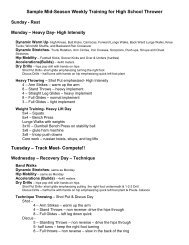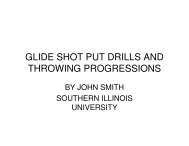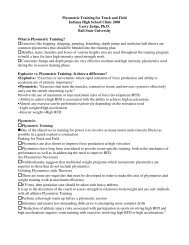Long Jump Training and Drills - iatccc
Long Jump Training and Drills - iatccc
Long Jump Training and Drills - iatccc
You also want an ePaper? Increase the reach of your titles
YUMPU automatically turns print PDFs into web optimized ePapers that Google loves.
Plyo <strong>Drills</strong><br />
1. SIDEWAYS BOX DRILL – to be done over 30/60 or 90 seconds. It is very explosive <strong>and</strong> the jumper must ensure that the contact time<br />
on the floor is minimal <strong>and</strong> that maximum height is attained on each drive from the floor.<br />
2. ALTERNATING PUSH OFF - The jumper places his foot flat on top of the platform. The jumper then drives vertically upwards <strong>and</strong><br />
must attempt to go as 'high as possible' to l<strong>and</strong> on top of the platform. The jumper then re-sets <strong>and</strong> repeats the drill on the other leg.<br />
You could do 5 sets of 5 per leg.<br />
3. HURDLE HOPS - Set out a number of hurdles [the height dependent on age <strong>and</strong> experience of jumper]. The jumper drives two-footed<br />
over the hurdles attempting to go for maximal height <strong>and</strong> limiting flexion at the knee on l<strong>and</strong>ing <strong>and</strong> DRIVING back up immediately<br />
on l<strong>and</strong>ing. Always maintain an upright upper torso. You could do 6 sets over 6 hurdles with 1 minutes recovery between each<br />
repetition.<br />
4. DROP DOWN REBOUND - The jumper 'steps' down - not out from a platform 60-90cms high, <strong>and</strong> on l<strong>and</strong>ing on a full foot DRIVES<br />
immediately upwards. There should be no forward lean on l<strong>and</strong>ing. The energy stored in the muscles as they lengthen MUST be used<br />
immediately<br />
5. DROP DOWN REBOUND TO SECOND BOX - The jumper ‘steps down’ <strong>and</strong> on l<strong>and</strong>ing on a full foot DRIVES immediately upwards<br />
VERTICALLY from the floor <strong>and</strong> l<strong>and</strong>s on the top of a second platform. You could extend the drill by using several platforms of<br />
varying heights. You might want to go from a lower platform to a series of higher platforms.<br />
6. DROP DOWN REBOUND TO ATTEMPT TO TOUCH OBJECT– The jumper will attempt to touch an object which is positioned high.<br />
In this example the jumper is rebounding quickly in an attempt to touch the rim of a basketball net.<br />
7. DROP DOWN REBOUND with a dynamic 'vertical impulse' over a hurdle – The jumper ‘steps down’ <strong>and</strong> on l<strong>and</strong>ing on a full foot<br />
drives vertically over a hurdle. The hurdle height is determined by age <strong>and</strong> experience. Remember, the jumper has to REACT<br />
QUICKLY on touchdown <strong>and</strong> drive up <strong>and</strong> use the stored elastic energy IMMEDIATELY. Ensure that the l<strong>and</strong>ing after the hurdle<br />
clearance is firm <strong>and</strong> balanced. There should be no excessive drop of the hips.<br />
A progression would be to place several hurdles in front of the platform.<br />
8. DROP DOWN REBOUND followed IMMEDIATELY with a St<strong>and</strong>ing <strong>Long</strong> <strong>Jump</strong> for distance - The main aim is to react<br />
immediately on touchdown <strong>and</strong> to DRIVE horizontally upwards <strong>and</strong> forwards. I tend to measure some of the repetitions from the toe<br />
to heel.<br />
9. Double footed bounding over a designated distance OR a set number of repetitions - The jumpers must limit the flexion behind<br />
the knee, keep upright <strong>and</strong> react IMMEDIATELY on l<strong>and</strong>ing on a full-foot <strong>and</strong> initiate a dynamic vertical impulse attempting the<br />
extend <strong>and</strong> straighten both legs on the 'upward journey'. I'm looking for height as opposed to distance.<br />
10. <strong>Jump</strong> up to platform - The platform is 90cms high <strong>and</strong> the jumper is lowering his hips slightly then EXPLODING upwards quickly to<br />
l<strong>and</strong> on top of the platform. Start at 60cms <strong>and</strong> build up to 90cms+ gradually. There should be no excessive drop of the hips to initiate<br />
the vertical impulse.<br />
11. St<strong>and</strong>ing <strong>Long</strong> <strong>Jump</strong> to vertical DRIVE upwards on to a platform [height depends on age <strong>and</strong> experience] - The jumper performs<br />
a st<strong>and</strong>ing long jump to a raised platform. IMMEDIATELY on l<strong>and</strong>ing the jumper changes his direction from the horizontal to the<br />
vertical. The jumper MUST try to go as high as possible <strong>and</strong> extend <strong>and</strong> lengthen the legs in the vertical impulse. You will note that<br />
the second repetition is by far the more efficient.<br />
12. DROP DOWN to FREEZE POSITION - Some research indicates that you need only perform the eccentric action without the following<br />
concentric action. I do this as a warm up but the majority of my drills have an eccentric [lengthening] action closely followed by a<br />
concentric [shortening] action.<br />
This isolated eccentric action still LOADS the muscle as it's lengthening.<br />
13. Moving Alternate Split Squat' - This drill is very dem<strong>and</strong>ing especially if you do 4 sets of 4-6 repetitions. Body positioning is very<br />
important - the jumper must try to keep his upper torso upright. I would have liked him to be a little bit more explosive in moving<br />
from one split squat to the next so we'll film this again very soon <strong>and</strong> you'll be able to see the difference.<br />
14. ONE LEGBOX JUMP – The jump hops from the floor up to a platform whose height is determined by the age <strong>and</strong> experience of the<br />
jumper. Both legs should be worked. The aim is to DRIVE VERTICALLY from the floor before l<strong>and</strong>ing on top of the platform.<br />
15. ONE LEG HURDLE HOPS – The jumper does a series of driving hops over a series of hurdles. The aim is to 'touch <strong>and</strong> go'. Again,<br />
posture is important. You can see that he catches his trailing leg on one of the hurdles. It's just a reminder that all exercises need total<br />
concentration on each repetition. A lot of the exercises are skill-based so the coach must ensure that corfect posture <strong>and</strong> mechanics<br />
are adhered to.<br />
16. Single leg bounding - x 5 both legs<br />
17. DYNAMIC SPLIT SQUAT DRIVE - In this drill the jumper gets into a wide split-squat position. With minimum sink to the ground he<br />
DRIVES VERTICALLY upwards from both feet attempting to achieve maximal height. On l<strong>and</strong>ing he must ensure that he does not sink<br />
towards the floor. He has to maintain a very strong split shape. On l<strong>and</strong>ing he DRIVES BACK VERTICALLY.<br />
He is showing a variation in that he is exchanging his legs at the apex of the vertical impulse.<br />
You might look to have your jumper doing a 3 sets of 5 with 1 minutes recovery between sets.<br />
18. THE HORIZONTAL TO VERTICAL DRILL In this drill the jumper is demonstrating a st<strong>and</strong>ing long jump to l<strong>and</strong> <strong>and</strong> immediately on<br />
l<strong>and</strong>ing -driving vertically attempting to achieve maximal height with NO MOVEMENT IN A FORWARDS DIRECTION. Again, the<br />
jumper is adhering to the ply metric principles of loading the relevant muscle groups as the muscle is lengthening [the stretchshortening<br />
cycle]. In this demonstration I would have liked Gareth to have l<strong>and</strong>ed a little higher from the horizontal impulse. I look<br />
for l<strong>and</strong>ings that replicate the take-off angle at the moment of touchdown <strong>and</strong> take-off. Here he has completed 3 reps. A typical drill<br />
would have the jumper doing 2 sets of 6 reps with 1 rep being a long jump with a vertical impulse. Recovery would be 2 minutes<br />
between sets<br />
19. St<strong>and</strong>ing long jump into one Hurdle hop<br />
20. St<strong>and</strong>ing long jump into two hurdle hops
















